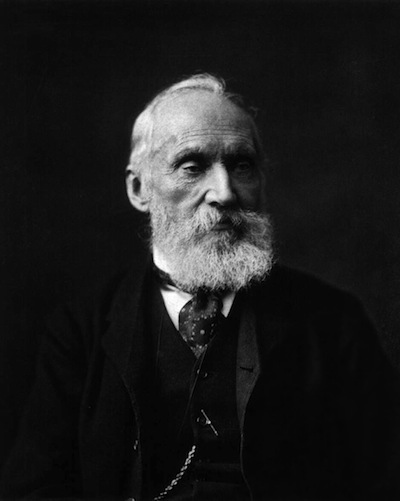Smaller than they look
/Suppose that you are standing on a pier at the edge of the Pacific Ocean. You have just created a new isotope of oxygen, 11O. Somehow, despite the fact that 12O is comically unstable and has a half-life of 580 yoctoseconds, 11O is stable. In your hand, you have a small glass of superlight water made with 11O, so that every molecule in the glass contains the new isotope.
You pour the water into the world's ocean and go home. In your will, you leave instructions to be handed down through generations of your family: wait several millennia for the world's ocean to mix completely. Then go to that pier, or any pier, and take a glass of water from the sea. Then count the 11O atoms in the glass.
What are the odds of getting one back?
 Kelvin. Public domain image sourced from the Smithsonian.I think this is the world's finest brainteaser. I believe it to be attributable to that great British polymath, William Thomson, the 1st Baron Kelvin (1824–1907). This man published more than 600 scientific papers. He would definitely have had a blog. He also had a passion for the sea, having been involved in the transatlantic cable project (along with Michael Faraday and Samuel Morse). So it seems plausible that he dreamt this problem up, and that's where Schrödinger thought he heard it (as told in an anecdote in his 1944 book What is life?).
Kelvin. Public domain image sourced from the Smithsonian.I think this is the world's finest brainteaser. I believe it to be attributable to that great British polymath, William Thomson, the 1st Baron Kelvin (1824–1907). This man published more than 600 scientific papers. He would definitely have had a blog. He also had a passion for the sea, having been involved in the transatlantic cable project (along with Michael Faraday and Samuel Morse). So it seems plausible that he dreamt this problem up, and that's where Schrödinger thought he heard it (as told in an anecdote in his 1944 book What is life?).
It's hard to believe, but if your glass holds just 250 ml, or just 8 fl oz in American units (as I like to call them), then you can expect to catch about 1600 molecules of your precious isotope. Think about that: every single glass of water in the ocean, contains 1600 of the molecules in that first little chalice. The thought of this genuinely makes my spine shiver, which is at least proof that I am a hopeless nerd.
Another way to look at the result is: there are more molecules in a glass of water than glasses of water in the ocean. This elaborate story really just illustrates how small molecules are: even smaller than they look. The mathematics is fairly simple: we want to divide the number of molecules in a glass of water by the number of glasses of water in the ocean, so
 Reading left to right, the glass is 0.25 L. Avogadro's number gives us the number of molecules in a mole of water. A mole of water is 0.018 kg, so we have to divide our actual volume by that. On the right, we simply have the volume of the world ocean, which is about 1.3 billion cubic kilometres according to Wikipedia. And we divide that by our glass volume to get the number of glasses in the ocean. This computes out to 1603—just Google this if you don't believe me: ((0.25 * 6 * 10^23)/0.018)/(1.3*10^21/0.25).
Reading left to right, the glass is 0.25 L. Avogadro's number gives us the number of molecules in a mole of water. A mole of water is 0.018 kg, so we have to divide our actual volume by that. On the right, we simply have the volume of the world ocean, which is about 1.3 billion cubic kilometres according to Wikipedia. And we divide that by our glass volume to get the number of glasses in the ocean. This computes out to 1603—just Google this if you don't believe me: ((0.25 * 6 * 10^23)/0.018)/(1.3*10^21/0.25).
1600 molecules—look at them all! You might want to think about this next time you pee in the sea.









 Except where noted, this content is licensed
Except where noted, this content is licensed